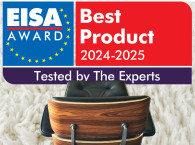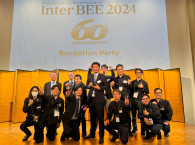Brown Named Thiel Audio’s Interim COO
Bob Brown, former longtime president/CEO of Lenbrook America (an exclusive US distributor of NAD and PSB brands), has been appointed to Thiel Audio’s board. He has also been hired as Thiel’s interim COO. Bob’s appointment follows Thiel’s recent acquisition by a Nashville-based private-equity firm that includes Thiel’s new CEO Bill Thomas, an audio enthusiast who until now has not been involved in the loudspeaker industry.
Brown will provide the company’s new owners with a complete analysis of the existing operation, including manufacturing, domestic and international sales, and marketing. Brown’s mission is to provide the guidance and market awareness necessary to maximize future opportunities. The new owners seem aware of the necessity to maintain the legacy aspect of Thiel Audio and appreciate the pitfalls that have plagued other investor-led high-end audio acquisitions. As Lenbrook America’s president/CEO, Brown distributed NAD Electronics and PSB Speakers. Brown has also been president/COO of Tivoli Audio. He is currently ZVOX Audio’s international sales manager, a position he maintains.
One of Brown’s first decisions was to hire former NAD National Sales Manager Stephen DeFuria as Thiel Audio’s new full-time National Sales Manager. DeFuria was most recently employed by Tempo High Fidelity as its North American sales manager for Musical Fidelity, the UK-based manufacturer of audio electronics. For more than 10 years beginning in 2001, DeFuria was national sales manager for NAD Electronics. At NAD, DeFuria was responsible for all aspects of US sales and marketing, including direct management of independent representatives, training initiatives, and trade show management. Previously, DeFuria was the principal of Audio Vision, a Boston-area hi-fi retailer that he acquired in 1984. DeFuria remained in audio retailing for approximately 19 years, selling Thiel products for 15 of those years. Thiel Audio manufactures 10 products ranging in cost from $1,090 each to $14,700 per pair.

Photo 1: Jeremy Berkhardt
Burkhardt Acquires Soundcast
Less than a year after leaving Nortek, a SpeakerCraft subsidiary, former SpeakerCraft CEO Jeremy Burkhardt has acquired Soundcast, a wireless outdoor-powered speaker manufacturer (see Photo 1).
Burkhardt sued Nortek in January 2013, alleging the parent company threatened to enforce a non-compete agreement that Burkhardt says is invalid. Joining Burkhardt at Soundcast is longtime SpeakerCraft alumni Jeff Francisco. Francisco will be taking over the position of Soundcast’s Chief Technology Officer, the same position he held at SpeakerCraft for approximately 24 years.

Photo 2: Startup menu for the THX home theater tune-up app
THX Releases Its First Mobile App

Photo 3: Adjustment and Extras menu for the THX home theater tune-up app
THX has released its first mobile iOS app, titled THX tune-up, for adjusting customers’ THX systems (or any other system). The new iPhone/iPad app will enable users to adjust their TVs, projectors, and speakers for maximum performance. Shown in Photo 2, the THX tune-up is being offered in the iTunes App Store for $1.99.
THX tune-up guides users through picture and sound adjustments to provide the best possible entertainment experience, plus it includes links to THX cinema trailers, the THX signature “THX Deep Note,” “Moo Can,” which plays the classic “moo” sound from a THX cinema trailer, and “Ask Tex,” which provides answers to any questions about home THX theater equipment and the setup process (Photo 3).
Custom-designed video patterns and audio test tones are provided to help users check for optimal video equipment settings based on both equipment capabilities and the room lighting environment. External speakers can also be measured for correct phase and connection.
Color and tint settings are often difficult to properly adjust without special glasses or other unique equipment. But, THX tune-up uses the iPad or an iPhone camera and a THX-designed built-in color filter to help consumers ensure colors are accurate and that skin tones appear natural.
The interactive app provides step-by-step instructions via narration and text and a detailed guide on how to use all its features.
Tests sequences available on the THX app include video adjustments and audio adjustments. The video adjustments feature:
Aspect ratio—Ensures your TV displays shapes and sizes correctly
Brightness—Adusts shadow details and night scenes so the picture is clearly visible
Contrast—Controls white detail
Color—Modifies colors so they are bright and vibrant but not overly saturated or cartoonish
Tint—Alters skin tones appear natural and are not too green or red
The audio adjustments feature:
Speaker assignment—Ensures that speakers are connected to the correct audio video receiver (AVR) output and intended sound is coming from the correct speaker
Speaker phase—Confirms that positive and negative speaker wires are correctly connected and all speakers are in phase
Although the new THX app is “pretty good,” the company said the tune-up app is not intended to provide full-calibration capabilities. It refers users to professional installers and calibrators for optimal fine-tuning results. THX plans to release an Android version of the tune-up app this spring.
New York Audio Show Set for April
This year’s New York Audio Show (the second ever) is scheduled for April 12–14, 2013, at the Palace Hotel in midtown Manhattan, NY. There will be demonstrations from more than 75 companies. Loudspeaker companies exhibiting at the New York Audio Show include Audio Engine, Coincident Speaker Technology, Dupuy Acoustique, Martin Logan, MBL North America, Naim Audio, PMC, Quad Musik, Raidho Acoustics, Robert Lighton Audio, Sanders Sound Systems, Sony, Spendor Audio Systems, TAD, Venture Audio, Waterfall Audio, Wilson Audio, and Zellaton.
Special events include a sneak-preview screening of Last Shop Standing, a film that charts the rise of record shops in the 1960s through 1980s, the impact of the best-sellers chart, vinyl’s demise, and the introduction CDs and other technologies had on music stores. The show will also host Classic Album Sundays, a record club that will hold listening sessions that feature songs from classic albums (e.g., Talking Heads’ Remain in Light, Kraftwerk’s Autobahn, and Love’s Forever Changes). Attendees will learn the history behind the featured albums and hear them on vinyl on a state-of-the-art, hi-fi system. Michael Fremer, editor of AnalogPlanet, will host daily workshops, including demonstrations on how to set up a turntable and how various pressings of the same album can sound radically different.
A series of clinics and seminars is also under development. The exhibits and demo rooms will be located on the conference center’s fourth and fifth floors and the hotel’s ninth, 10th and 11th floors.
Produced by the UK-based Chester Group, this second annual show is designed to share the wonder of music through quality audio. “Our inaugural US event last year confirmed there is a strong desire in the New York area to experience music beyond MP3 players,” said Roy Bird, Chester Group’s chairman. “We are building upon that success with special events that will create even more excitement, and we are thrilled that the New York Audio Show has been selected to preview the Last Shop Standing.”
NAMM’s Award Winners
The following products received the National Association of Music Merchants (NAMM) 2013 Best of Show Awards for loudspeaker design:

Photo 4: The Electrovoice ZLX PA speaker
Electro-Voice ZLX Portable PA—Available in 12” and 15” two-way versions, Electro-Voice’s new ZLX line of portable powered loudspeakers are intended for use as either mains or monitors (see Photo 4). The ZLX portable, powered loudspeakers include a 1,000-W Class-D amplifier, a single-knob DSP control with an LCD and application/location presets, input level meters, independent amplifier control, and a patented split-baffle design. With pole-mounted capabilities, the loudspeaker enclosures feature composite construction with high/low grip design.

Photo 5: The JBL M2 mastering monitors
JBL M2 Master Reference Monitor—The largest speaker in JBL’s studio monitor line, the M2 Master Reference Monitor, integrates new JBL transducer technologies in a free-standing, two-way system (see Photo 5). The M2 design includes JBL’s new D2 compression driver, which uses two annular diaphragms and two voice coils; JBL’s new 2216ND differential drive 15” woofer, with dual voice coils; and a patented wire application said to reduce power compression and enable linear output regardless of the playback level. The M2 Master Reference Monitor delivers 20-to-40-kHz extended in-room response, and 123-dB SPL at 1 m. The M2 also utilizes JBL’s patent-pending waveguide “Image Control,” said to enable neutral frequency response, both on- and off-axis in the vertical and horizontal planes down to the M2’s 800-Hz crossover point.

Photo 6: The M Audio M3-8 three-way studio monitors
M-Audio M3-8 Studio Reference Monitor—M-Audio’s M3-8 three-way studio reference monitor features an 8” woven Kevlar low-frequency driver, 5” woven Kevlar mid-frequency driver, and a 1” silk dome tweeter with an integrated guard (see Photo 6). The speaker comes in an attractive, wooden mahogany case with wooden internal baffling and delivers 220-W of tri-amp Class A/B power. It has a three-band EQ with bypass, a switchable low-cut filter, an XLR and 0.25” balanced and RCA unbalanced input are provided.

Photo 7: The PreSonos S6 and S8 coaxial studio monitors
PreSonus Sceptre S6 & S8 Studio Monitor—Released in partnership with Fulcrum Acoustic, PreSonus’s Sceptre CoActual Series studio reference monitors include an 8” low/mid-frequency driver and a 1” (25-mm), horn-loaded, high-frequency transducer within a single coaxial unit with aligned voice coils (see Photo 7). The Sceptre S6 CoActual studio monitor’s coaxial speaker integrates a 6.5” low/mid-frequency driver and a 1” (25-mm), horn-loaded, high-frequency transducer. Both models have acoustic ports. The monitors incorporate TQ algorithms, and a four-position Acoustic Space switch controls a second-order shelving filter centered at 100 Hz, with four attenuation settings (no attenuation, –1.5, –3, and –6 dB) so users can account for the bass response relative to room dimensions and speaker placement. VC






